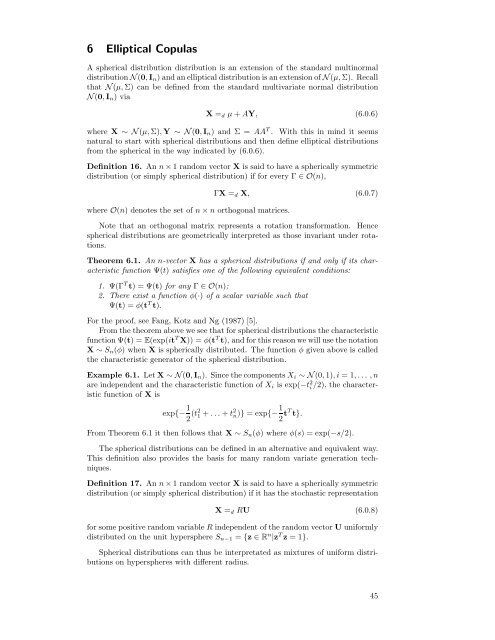Modelling Dependence with Copulas - IFOR
Modelling Dependence with Copulas - IFOR
Modelling Dependence with Copulas - IFOR
You also want an ePaper? Increase the reach of your titles
YUMPU automatically turns print PDFs into web optimized ePapers that Google loves.
6 Elliptical <strong>Copulas</strong><br />
A spherical distribution distribution is an extension of the standard multinormal<br />
distribution N (0, I n ) and an elliptical distribution is an extension of N (µ, Σ). Recall<br />
that N (µ, Σ) can be defined from the standard multivariate normal distribution<br />
N (0, I n )via<br />
X = d µ + AY, (6.0.6)<br />
where X ∼N(µ, Σ), Y ∼N(0, I n )andΣ=AA T . With this in mind it seems<br />
natural to start <strong>with</strong> spherical distributions and then define elliptical distributions<br />
from the spherical in the way indicated by (6.0.6).<br />
Definition 16. An n × 1 random vector X is said to have a spherically symmetric<br />
distribution (or simply spherical distribution) if for every Γ ∈O(n),<br />
where O(n) denotes the set of n × n orthogonal matrices.<br />
ΓX = d X, (6.0.7)<br />
Note that an orthogonal matrix represents a rotation transformation. Hence<br />
spherical distributions are geometrically interpreted as those invariant under rotations.<br />
Theorem 6.1. An n-vector X has a spherical distributions if and only if its characteristic<br />
function Ψ(t) satisfies one of the following equivalent conditions:<br />
1. Ψ(Γ T t)=Ψ(t) for any Γ ∈O(n);<br />
2. There exist a function φ(·) of a scalar variable such that<br />
Ψ(t) =φ(t T t).<br />
For the proof, see Fang, Kotz and Ng (1987) [5].<br />
From the theorem above we see that for spherical distributions the characteristic<br />
function Ψ(t) =E(exp(it T X)) = φ(t T t), and for this reason we will use the notation<br />
X ∼ S n (φ) whenX is spherically distributed. The function φ given above is called<br />
the characteristic generator of the spherical distribution.<br />
Example 6.1. Let X ∼N(0, I n ). Since the components X i ∼N(0, 1),i=1,... ,n<br />
are independent and the characteristic function of X i is exp(−t 2 i /2), the characteristic<br />
function of X is<br />
exp{− 1 2 (t2 1 + ...+ t 2 n)} =exp{− 1 2 tT t}.<br />
From Theorem 6.1 it then follows that X ∼ S n (φ) whereφ(s) =exp(−s/2).<br />
The spherical distributions can be defined in an alternative and equivalent way.<br />
This definition also provides the basis for many random variate generation techniques.<br />
Definition 17. An n × 1 random vector X is said to have a spherically symmetric<br />
distribution (or simply spherical distribution) if it has the stochastic representation<br />
X = d RU (6.0.8)<br />
for some positive random variable R independent of the random vector U uniformly<br />
distributed on the unit hypersphere S n−1 = {z ∈ R n |z T z =1}.<br />
Spherical distributions can thus be interpretated as mixtures of uniform distributions<br />
on hyperspheres <strong>with</strong> different radius.<br />
45
















